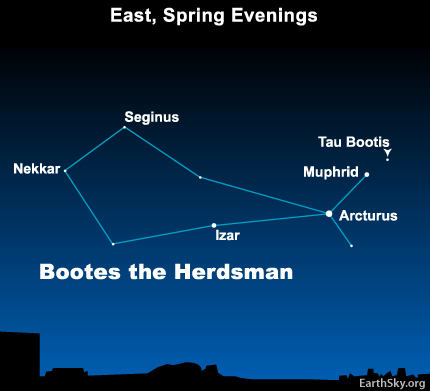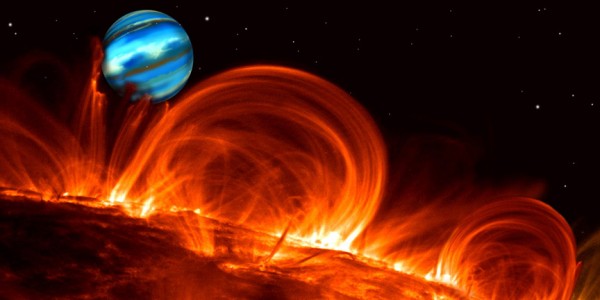
Tonight … a word about a faint star in the constellation Bootes the Herdsman that made astronomical history in the year 2007. In that year, an international team of astronomers, led by Jean-Francis Donati and Claire Montau of France, caught the star Tau Boötis flipping its north and south magnetic poles. These astronomers had been mapping the magnetic fields of stars. It was the first time a magnetic reversal had been observed on any star other than our sun. The astronomers published their work in the peer-reviewed journal Monthly Notices of the Royal Astronomical Society in 2008.
Astronomers intently watched Tau Boötis for more magnetic turnovers, and it appears this star undergoes magnetic reversals in periods of about two years. They’re hoping Tau Boötis will enable them to understand how magnetic engines drive stars, including our sun.
You can see this star. Tau Boötis is faintly visible in a dark country sky. Look eastward on these April evenings for the blazing yellow-orange star Arcturus, the brightest in your eastern sky. To verify that you’re looking at Arcturus, look for the Big Dipper up high in your northern sky. Follow the arc of the Big Dipper’s handle to Arcturus.
You’ll need a dark country sky and a moon-free night to see Tau Boötis with the unaided eye. This star is nearly 70 times fainter than Arcturus. On these northern spring evenings, the star Muphrid shines to the upper right of Arcturus, and Tau Boötis lodges to the upper right of Muphrid.

Our sun undergoes magnetic reversals, too. The sun’s magnetic polarity flips approximately every 11 years, defining what astronomers call the solar cycle. The peak of the most recent cycle – Sunspot Cycle 24 – was probably early 2014. Magnetic reversals are part of our sun’s normal activity, and it’s likely other stars similar to our sun in the Milky Way galaxy (and other galaxies) also undergo magnetic reversals.
The video below, published on YouTube December 6, 2013 – when the current solar cycle was near its peak – features solar astrophysicist Alex Young. He talks about Cycle 24 and about what a magnetic flip means for Earth.
Now check out another cool video, below. It’s from NASA’s Goddard Space Flight Center and is a visualization, showing the position of the sun’s magnetic fields from January 1997 to December 2013. Magenta lines show where the sun’s overall field is negative and the green lines show where it is positive. A region with more electrons is negative, the region with less is labeled positive. Additional gray lines represent areas of local magnetic variation.
The visualization shows how, in 1997, the sun showed positive polarity on the top and negative polarity on the bottom. Over the next 12 years, each set of lines is seen to creep toward the opposite pole, eventually showing a complete flip.
Fun to think that other stars (most likely) do this, too!
Bottom line: The star Tau Boötis has been seen to flip its north and south magnetic poles. It was the first star, other than our sun, ever seen to do so. This post includes 2 great videos about our sun’s magnetic pole reversals.
Enjoying EarthSky so far? Sign up for our free daily newsletter today!
EarthSky astronomy kits are perfect for beginners. Order today from the EarthSky store











